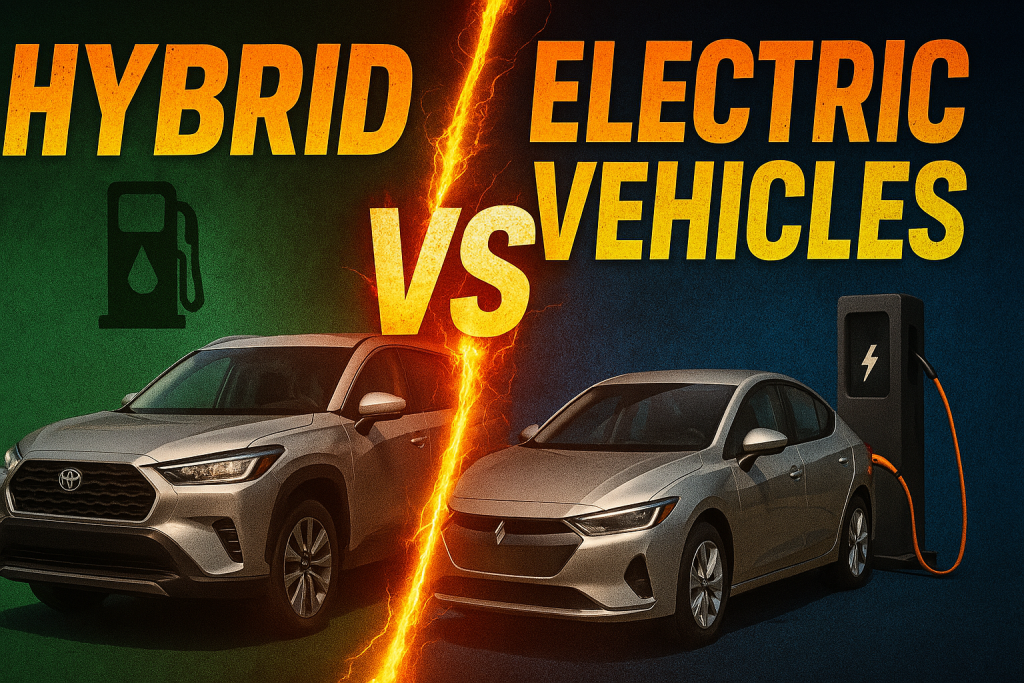As the global shift to cleaner mobility accelerates, a hot debate continues: Will hybrid cars dominate over electric vehicles (EVs) in the coming years? While both technologies are surging in popularity, data shows diverging trends across regions. In this post, we break down the global and regional performance of EVs vs. hybrids, including plug-in hybrids (PHEVs), and forecast what lies ahead.
Global Market Overview: EVs and Hybrids (2019–2023)
The last five years have seen explosive growth in both hybrid and electric vehicle markets. Here’s a snapshot of global sales in millions:
| Year | Battery EVs | Hybrids & PHEVs |
|---|---|---|
| 2019 | 1.5 | 3.0 |
| 2020 | 2.2 | 3.0 |
| 2021 | 4.8 | 6.0 |
| 2022 | 7.7 | 8.0 |
| 2023 | 10.0 | 10.0 |
In 2023, both battery electric vehicles (BEVs) and hybrids (including PHEVs) reached around 10 million units in global sales. This puts both technologies at roughly 13–15% of total new car sales worldwide. This parity is significant, signaling a world in transition between two key low-emission technologies.
United States: Hybrid Momentum Still Strong
In the U.S., hybrid vehicles have maintained a lead over BEVs for now. In 2023:
- BEV sales: ~1 million units (~7% of market share)
- Hybrid & PHEV sales: ~1.18 million units (~10% of market share)
Strong demand for fuel-efficient, cost-effective alternatives has kept hybrids popular, especially in areas where charging infrastructure is still developing. Many buyers see hybrids as a safe stepping stone—offering fuel savings without worrying about charging access.
Meanwhile, federal incentives like the Inflation Reduction Act (IRA) and improvements in charging infrastructure are giving BEVs a boost. Tesla, Ford, GM, and others are expanding EV production, which could shift the momentum in coming years.
European Union: EVs Gaining the Upper Hand
Europe has taken aggressive steps toward decarbonizing transport. The results are clear:
- BEV sales in 2023: 1.6 million (~15% market share)
- PHEV share: ~8%
- Non-plug hybrids: 25.8% of total new car sales (2.7 million units)
Countries like Norway, Germany, and the Netherlands are leading this shift, with BEVs often outselling even gasoline models. The European Union’s mandate to ban internal combustion engine (ICE) car sales by 2035 has accelerated innovation and adoption.
Europe also benefits from a strong charging infrastructure and broad public support for green mobility. With both consumer and government alignment, the EU could see EVs overtake hybrids in the next 2–3 years.
India: Small Base, Rapid Growth
India’s EV and hybrid markets are still emerging but growing fast:
- EV car sales in 2023: ~82,700 (~2% market share)
- Hybrid car sales in 2023: ~82,600 (~2% market share)
Although both EV and hybrid sales are small, their growth rates are impressive—more than doubling from 2022. Urban areas like Delhi, Mumbai, and Bengaluru are becoming early adopters.
India’s government is promoting EVs through the FAME II scheme, while many automakers are introducing affordable hybrid models that work better in regions with sparse charging facilities. In rural and semi-urban areas, hybrids currently offer a more realistic alternative.
Plug-in Hybrids (PHEVs): A Compromise Solution
Plug-in hybrids offer the best of both worlds: electric-only short-range driving and a combustion engine for longer trips. In 2023, PHEVs accounted for about 4.2 million global sales.
In countries like China and Germany, PHEVs are particularly popular. They help drivers transition to EV use without the “range anxiety” often associated with fully electric cars. Automakers are leveraging PHEVs as part of their strategy to reduce emissions while waiting for the charging network and battery tech to mature.
However, PHEVs are sometimes criticized for being underutilized in electric mode. Regulatory bodies in the EU are now considering stricter standards to ensure PHEVs are used more effectively.
Growth Trends and Market Outlook
EVs have grown at an average rate of 35% annually since 2020. Battery technology improvements, falling costs, and expanding charging infrastructure are key drivers. Meanwhile, hybrids and PHEVs are growing too, but slightly slower.
Charging Infrastructure
- Over 3 million public EV chargers are now installed globally.
- Major markets like the EU, U.S., and China are investing billions in expanding networks.
As infrastructure improves, the range advantage of hybrids will diminish, favoring EVs in the long term.
Government Incentives and Policy Push
- Europe: ICE vehicle ban by 2035, generous EV tax benefits.
- USA: Federal EV tax credits, state-level rebates, and investment in charging.
- India: FAME II subsidy program, state incentives, and reduced GST on EVs.
These initiatives are designed to support full electrification over hybrid alternatives. In fact, many of the latest policy updates prioritize BEVs over hybrids, signaling a long-term commitment to zero-emission mobility.
Automaker Strategy
Global automakers are betting big on electrification:
- General Motors plans an all-electric lineup by 2035.
- Mercedes-Benz and Volvo aim to go all-electric by 2030.
- Toyota and Honda, leaders in hybrid tech, are also ramping up BEV development.
This industry-wide pivot reflects both consumer trends and tightening emission regulations.
Projections: Who Will Win?
Most experts agree that fully electric vehicles will eventually dominate.
BloombergNEF Forecast:
- EVs (including PHEVs) to reach 44% of global new car sales by 2030.
IEA Outlook:
- Pure EVs to become the majority of new sales in many regions by the early 2030s.
The rapid pace of technological advancements—especially in battery tech, range, and affordability—favors BEVs over hybrids in the long term.
Conclusion: The Inevitable Rise of Electric Vehicles
While hybrid cars (especially PHEVs) are booming today, especially in cost-sensitive or infrastructure-limited markets, their role is likely transitional. The real momentum and future lies with electric vehicles, driven by policy, technology, and long-term sustainability goals.
In summary:
- Short-term: Hybrids and PHEVs offer an accessible bridge for consumers.
- Long-term: EVs will dominate as charging becomes widespread and prices drop.
- Global trend: EVs are outpacing hybrids in most forward-looking markets.
So, will hybrids outsell EVs in the coming years? Possibly in the near term in select markets. But globally, the future belongs to electric vehicles.




